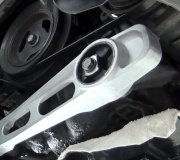Hi srtinner. Welcome to the forum. I'm making some educated guesses here. If the front pads were worn, the brake fluid level in the reservoir was most likely low too. As the pads wear down, the pistons in the calipers move out as the self-adjusting feature. Fluid leaves the reservoir to fill in behind the pistons. Later, when the new pads are installed, the pistons have to be pried back in and that sends the fluid back up to the reservoir.
When the fluid level is low, driving down a steep slope could have let air enter the hydraulic system. Since that air is close to the reservoir, it will work its way out in a few days but in the meantime, GM has a unique problem caused by the design of their master cylinder. There is a valve that trips to block fluid from flowing through a line with a perceived leak. Air in the line mimics a leak. When that valve trips, fluid will only flow to one front brake and the opposite rear brake. On some cars, people don't even notice that only half the brakes are working. What they notice is one front brake starts grinding metal-on-metal because it's worn out and the other side looks like new yet. On some cars, like yours, it is very noticeable with the symptoms you described.
You can prove to yourself if this is what happened by trying to bleed the brakes at the wheels or at the lines coming off the master cylinder. You will find no fluid will flow from two lines at the master cylinder or from one front and one rear brake. If that is the case, I have not found any way to reset the valve other than to give it a quick short burst of compressed air through the bleeder screw on one of the wheels that won't bleed. After that, loosen the cover on the reservoir and wait for that wheel to gravity bleed. Close the bleeder screw, then press the brake pedal, (NEVER more than half way to the floor), a couple of times, then open the bleeder screw once more to expel any tiny remaining air bubbles.
Caradiodoc
SPONSORED LINKS
Friday, August 13th, 2010 AT 5:52 PM

